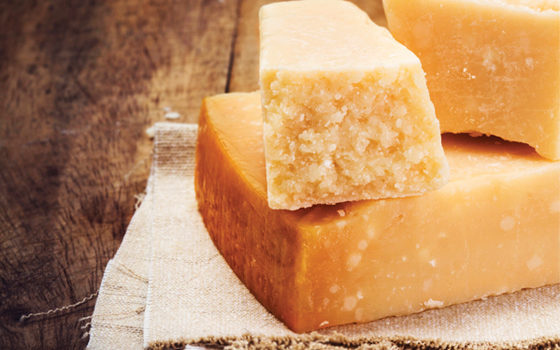Follow the guide!
Canada’s Food Guide recommends consuming two to four servings of dairy products daily.
| CHILDREN |
TEENS |
ADULTS |
| Aged 2 to 8 |
Aged 9 to 13 |
Aged 14 à 18 |
Aged 19 to 50 |
Aged 51+ |
| 2 servings |
3 to 4 servings |
3 to 4 servings |
2 servings |
3 servings |
Countless benefits
Calcium is essential for bone health, but there are many other benefits!
Calcium:
- regulates your heartbeat.
- stimulates muscle contraction.
- helps prevent high blood pressure.
- helps transmit nerve and hormone signals to various parts of the body.
Are you familiar with osteoporosis?
In Canada, one in four women and one in eight men over the age of 50 suffer from osteoporosis, a disease characterized by weakened bones.
Take care of your bones!
- Make sure you get enough calcium and vitamin D each day!
Everyday strategies
Here are some tips to optimize your calcium intake:
- Eat a variety of milk-based desserts (panna cotta, blancmange, etc.).
- Sprinkle cheese over your meat and pasta dishes.
- Eat yogurt for dessert.
- Add milk to your soups.
How much calcium do you need?
| Age group |
Calcium requirement |
| Children aged 2 to 8 |
500 to 800 mg/day |
| Children and teens aged 9 to 18 |
1,300 mg per day |
| Adults aged 19 to 50 |
1,000 mg per day |
| Adults over 50 |
1,200 mg per day |
| Pregnant or breastfeeding women |
1,000 to 1,300 mg per day |
How get enough calcium
Dairy products are definitely a great choice to add calcium to your diet! Calcium is also found in sardines, canned salmon with bones, tofu, fortified soy drinks, bok choy, rapini, broccoli, sesame seeds and almonds. However, some substances in these foods may bind to calcium and inhibit its absorption.
Are you getting enough calcium?
Take a look at the following tables and compare them to your daily diet!
Dairy products
| Food name |
Serving size |
Calcium content |
| Emmental, Gruyère |
50 g (2 1-inch cubes) |
521 mg |
| Ricotta |
125 mL (½ cup) |
356 mg |
| Cheddar, gouda, brick |
50 g (2 1-inch cubes) |
350 mg |
| Feta, mozzarella, camembert, blue cheese |
50 g (2 1-inch cubes) |
230 mg |
| Parmesan, romano |
15 mL (1 tbsp.) grated cheese |
67 mg |
| Cow’s milk 0% to 3.25% M.F. |
250 mL (1 cup) |
308 mg |
| Plain yogurt 0% to 3.25% M.F. |
175 mL (¾ cup) |
303 mg |
| Flavoured or fruit yogurt 0% to 4% M.F. |
Small 100 g format |
141 mg |
| Drinkable yogurt |
125 mL (½ cup) |
137 mg |
Other sources
| Food name |
Serving size |
Calcium content |
| Soy beverage, enriched |
250 mL (1 cup) |
344 mg |
| Tofu, regular, made with calcium chloride |
100 g (3 oz.) |
350 mg |
| Sardines, canned bone-in |
100 g (8 medium) |
318 mg |
| Salmon, canned bone-in |
100 g (3 oz.) |
220 mg |
| Black-eyed peas, cooked |
250 mL (1 cup) |
212 mg |
| Sesame seeds, unhulled |
30 mL (2 tbsp.) avocado oil |
176 mg |
| Orange juice, fortified |
125 mL (½ cup) |
160 mg |
| Clams, canned |
100 g (3 oz.) |
91 mg |
| Bok choy, boiled |
125 mL (½ cup) |
84 mg |
| Rapini, cooked |
125 mL (½ cup) |
78 mg |
| Almonds |
28 g (23 almonds) |
75 mg |
| Broccoli, cooked |
250 mL (1 cup) |
66 mg |
| Orange |
1 medium |
52 mg |
Source: Health Canada, Canadian Nutrient File, version 2007b.
Calcium on the menu:
The calcium shake-up!
Milkshake
Double the goodness with double the calcium!
Rapini with sesame seeds
Berries are just so delicious!
Ricotta cheese
Exotically calcium!
Yogurt with almonds
Needing a supplement?
Not if you consume the recommended daily amount of milk or calcium-rich alternatives listed in
Canada’s Food Guide (two to three servings for adults) and eat a balanced and varied diet! However, women who are postmenopausal, pregnant, breastfeeding or of childbearing age, as well as those who consume very little dairy, may need to increase their intake of calcium-rich foods to meet their daily requirements.
Good to know:
- Supplements containing bonemeal or dolomite may contain traces of lead and should be avoided.
- Do you suffer from chronic constipation, kidney disease or heart problems?
Consult with your doctor before taking supplements of any kind.

